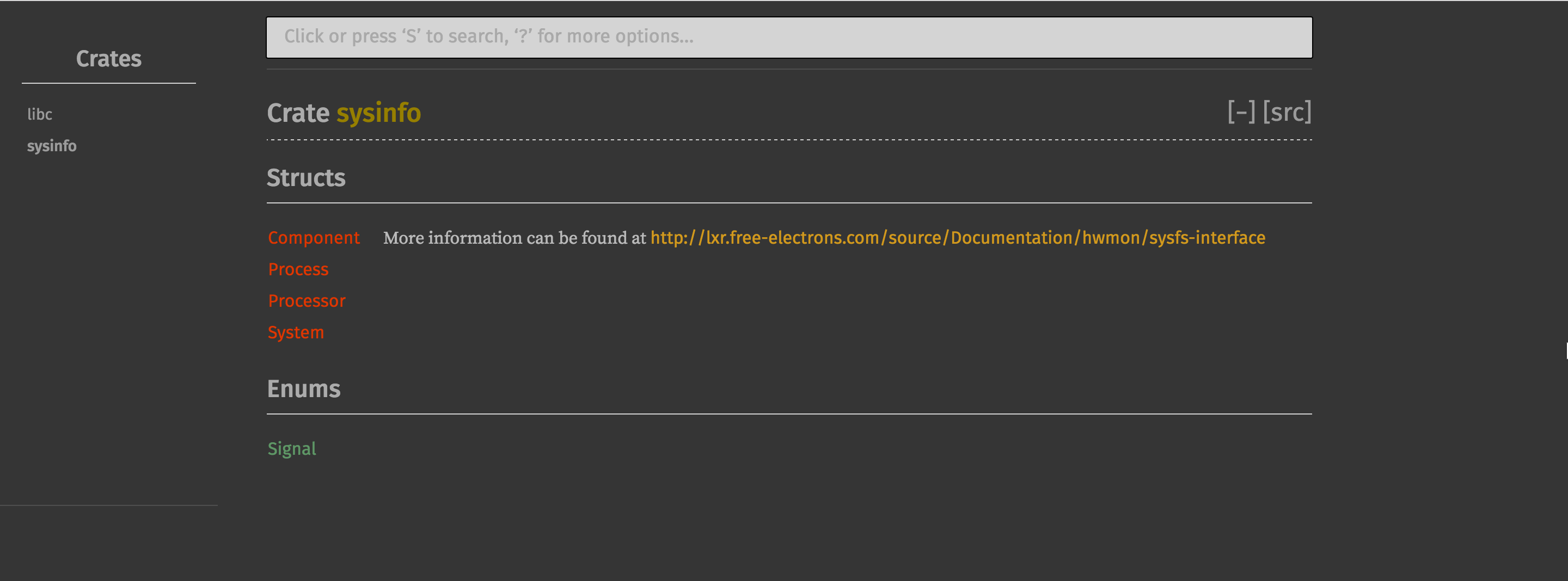
Only a few people know, but it's actually possible (at least only on nightly) to generate doc with another color theme has been possible for a few months now. I personally prefer dark ones so in here I'll use this CSS file:
/**
* Copyright 2016 Guillaume Gomez
*/
body {
background-color: #353535;
color: #BABABA;
}
h1, h2, h3:not(.impl):not(.method):not(.type):not(.tymethod), h4:not(.method):not(.type):not(.tymethod) {
color: #ababab;
}
h1.fqn {
border-bottom-color: #d2d2d2;
}
h2, h3:not(.impl):not(.method):not(.type):not(.tymethod), h4:not(.method):not(.type):not(.tymethod) {
border-bottom-color: #d2d2d2;
}
.in-band {
background-color: #353535;
}
.docblock code {
background-color: #2A2A2A;
}
pre {
background-color: #2A2A2A;
}
.sidebar .location {
background: #575757;
color: #DDD;
}
.block a:hover {
background: #444;
}
.line-numbers span { color: #3B91E2; }
.line-numbers .line-highlighted {
background-color: #0a042f !important;
}
:target { background: #484848; }
.content .highlighted {
color: #eee !important;
background-color: #333;
}
.content .highlighted a, .content .highlighted span { color: #eee !important; }
.content .highlighted.trait { background-color: #013191; }
.content .highlighted.mod { background-color: #803a1b; }
.content .highlighted.enum { background-color: #5b4e68; }
.content .highlighted.struct { background-color: #194e9f; }
.content .highlighted.fn { background-color: #4950ed; }
.content .highlighted.method { background-color: #39802e; }
.content .highlighted.tymethod { background-color: #39802d; }
.content .highlighted.type { background-color: #38902c; }
.docblock h1, .docblock h2, .docblock h3, .docblock h4, .docblock h5 {
border-bottom-color: 1px solid #333;
}
.docblock table {
border-color: #333;
}
.docblock table td {
border-top-color: #333;
border-bottom-color: #333;
}
.docblock table th {
border-top-color: #333;
border-bottom-color: #333;
}
.content span.primitive, .content a.primitive, .block a.current.primitive { color: #D8AA0B; }
.content span.externcrate,
.content span.mod, .content a.mod, block a.current.mod { color: #967F00; }
.content span.fn, .content a.fn, .block a.current.fn,
.content span.method, .content a.method, .block a.current.method,
.content span.tymethod, .content a.tymethod, .block a.current.tymethod,
.content .fnname { color: #2BAB63; }
pre.rust .comment { color: #4D4D4C; }
pre.rust .doccomment { color: #8E908C; }
nav {
border-bottom-color: #4e4e4e;
}
nav.main .current {
border-top-color: #eee;
border-bottom-color: #eee;
}
nav.main .separator {
border-color: #eee;
}
a {
color: #9B9B9B;
}
.docblock a, .stability a {
color: #D2991D;
}
a.test-arrow {
color: #dedede;
}
.content span.trait, .content a.trait, .block a.current.trait { color: #88aa00; }
.search-input {
color: #111;
box-shadow: 0 0 0 1px #000, 0 0 0 2px transparent;
background-color: #d4d4d4;
}
em.stab.unstable { background: #503D05; border-color: #AB8500; }
em.stab.deprecated { background: #352850; border-color: #645074; }The option to enable rustdoc to add a custom CSS file while you're generating doc is --extend-css. However, it isn't stable yet so you also need to use -Z unstable-options. Which gives us:
rustdoc -Z unstable-options --extend-css dark.cssA bit heavy for the moment, but I have good hopes that it'll get stabilized in a (close?) future!
Of course, you can also use it with cargo which now supports rustdoc options with the RUSTDOCFLAGS flag. Example:
RUSTDOCFLAGS='-Z unstable-options --extend-css dark.css' cargo docAnd you're good to go! We can now conclude with a nice screenshot:

Bonus: The official rust-language twitter account retwitted this article:
Generating Rustdoc with a custom style https://t.co/criFmUK6lP
— Rust Language (@rustlang) September 16, 2016